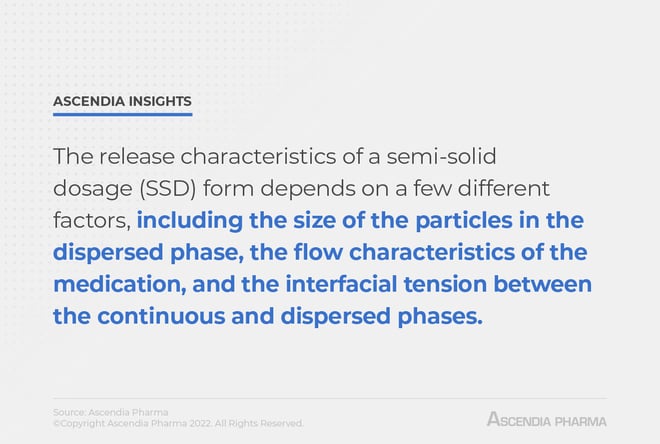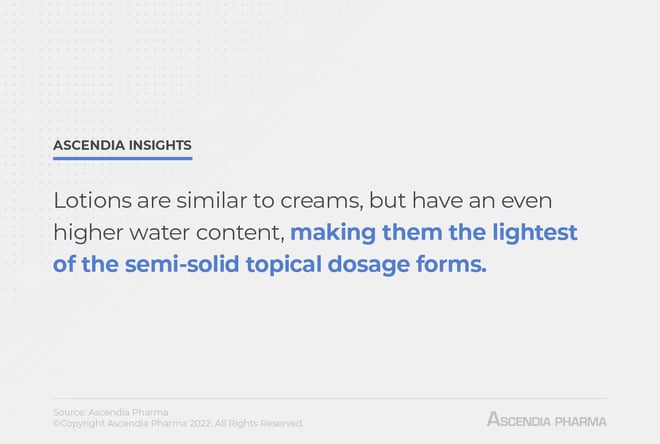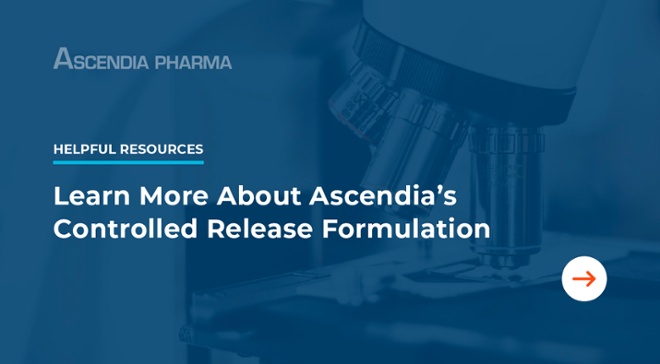Semi-Solid and Semi-Liquid Dosage Forms: What to Know
Interest in semi-solid dosage forms has been on the rise in recent years, as has the demand for CDMOs with experience developing these products. Sometimes known as semi-liquid dosages, these drugs are easy to administer and can be produced in a variety of formulations. That said, there are challenges in developing and manufacturing semi-solid dosage forms that must be considered.

What Is a Semi-Solid Dosage Form?
Semi-solid dosage (SSD) forms are a type of medication that is neither solid nor liquid; they are somewhere in between the two states. These medications are applied to the skin, nasal mucosa, cornea, rectal or vaginal tissue (often via suppository), buccal tissue, ear, or urethral membrane.
SSD forms often involve two phases: oil and water. One phase is continuous, or external, while the other phase is dispersed, or internal. Active ingredients can be dissolved in one or both phases.
Ideally, a semi-solid dosage form has a smooth texture, without any grittiness; it will be non-dehydrating, non-hygroscopic, non-staining, and non-greasy, although not all SSD forms meet all of these criteria (ointments, for example, are both greasy and staining). Because these drugs are applied to the skin, they shouldn’t cause irritation, sensitization, or change the way the skin functions.
The release characteristics of an SSD form depends on a few different factors, including the size of the particles in the dispersed phase, the flow characteristics of the medication, and the interfacial tension between the continuous and dispersed phases.
>> Related Read - Drug Formulation Development Process: Notes from a CDMO
Topical vs. Transdermal
It's important to note that semi-solid dosages can be topical or transdermal. Topical semi-solid dosage forms are applied to the surface of the skin and remain there. Topical dosages are typically used to treat dermatological conditions like acne vulgaris, infections, wounds to the skin, and eczema.
In contrast, transdermal semi-solid dosage forms are designed to be absorbed through the skin into the bloodstream. Transdermal dosages are typically used to treat conditions that require ongoing medication, such as pain management. Birth control and smoking cessation medications can also be delivered in a transdermal manner.
Types of Semi-Solid Dosage Forms
Semi-solid dosages for topical and transdermal use come in a number of different forms. The following are the most common:
Ointments
Ointments are SSD forms that are designed for external use. They are typically made with a combination of oil and water, as well as other ingredients like pharmaceutical-grade waxes, emulsifiers, and preservatives. Ointments are thicker than creams and lotions, making them ideal for treating conditions like eczema, as they also provide a layer of protection for the skin.
There are four categories of ointments:
- Hydrocarbon or oleaginous bases – Oil-based bases that are occlusive, emollient, and long-lasting.
- Emulsion or water miscible bases – Water-in-oil or oil-in-water emulsions.
- Absorbent bases – These include water-in-oil emulsions with aqueous solutions and water-in-oil emulsions with oil-soluble active ingredients.
- Water soluble bases – A non-greasy dosage that can be washed away with water; many have a polyethylene glycol base.
 Creams and Lotions
Creams and Lotions
Creams are also designed for topical use. They are similar to ointments, but typically have an opaque appearance and a higher water content and less oil. This makes them less greasy than ointments and easier to spread over large areas of skin. Creams can be water-in-oil or oil-in-water.
Lotions are similar to creams, but have an even higher water content, making them the lightest of the semi-solid topical dosage forms. Some lotions also contain alcohol.
Pastes
Pastes have a thicker consistency than ointments, as they are a mixture of powder and ointment. They may be designed for both topical and transdermal use. They can be difficult to apply evenly and to large areas; as such, pastes are most often used to treat localized conditions, like athlete's foot.
Gels
Gels are semi-solid dosage forms that can be either topical or transdermal. They are aqueous colloidal suspensions with a liquid phase that is entrapped in a polymeric matrix. Gels tend to be clear or translucent, and their smooth consistency makes them easy to apply evenly over large areas of skin. In addition to being used as a medication, they can also be used as lubrication.
Jellies
Jellies have a similar consistency to gels, but are designed for topical use only. They are typically made with a combination of water, an active ingredient, and other ingredients like gelling agents, emulsifiers, and preservatives. Jellies are used to treat conditions like vaginal dryness.
Poultices
Poultices, or cataplasms, are an SSD form that is meant for topical use only. A medication is applied to a cloth or dressing, then this dressing is placed on the area being treated. Poultices are often used to treat skin conditions like boils or sunburn, although they are also used to alleviate soreness and inflammation.
>> Related Read - Drug Formulation Development: Quick Reference Guide
Suppositories
Suppositories are a transdermal semi-solid dosage form. They have an external membrane that melts, dissolves, or softens at body temperature, which releases the active ingredient so it can be absorbed into the bloodstream. Suppositories are inserted into a body cavity, such as the vagina or rectum.
Plasters
Medicated plaster is typically made with a combination of plaster, water, and an active ingredient. The plaster is applied to the skin where it hardens and provides a slow, steady release of medication over time. Salicylic acid can be applied via medicated plaster for the treatment of skin and plantar warts.
Rigid Foams
Medicated foams are a unique drug delivery system. Gas bubbles are distributed in a liquid, which contains the active pharmaceutical ingredient (API) and excipients. Topical foams are used to deliver a variety of active ingredients, including corticosteroids, antimicrobials, and chemical sunscreens.
Glycerogelatins
Glycerogelatins are a semi-solid dosage form that can be used for sustained release. They are typically made with a combination of glycerin and gelatin, along with the active ingredient.
 Benefits of Semi-Liquid Dosage Forms
Benefits of Semi-Liquid Dosage Forms
There are many benefits of semi-liquid dosage forms, including:
External Use
The fact that SSD forms are applied externally makes them easier to take for many patients, which increases compliance. External use also means there is a lower risk of gastrointestinal difficulties from taking a medication orally.
Reduced Side Effects
Topical formulations can effectively treat dermatological conditions without systemic exposure, which reduces the number of side effects experienced by patients.
Avoids First-Pass Effect
First-pass metabolism can vary from one patient to the next, causing a great deal of variability in the effectiveness of a drug. Transdermal drugs are absorbed into the bloodstream, avoiding first-pass metabolism for more consistency and predictability.
Controlled Release
Some transdermal delivery systems provide controlled release, which means the level of a drug in the bloodstream has fewer fluctuations. This can result in fewer side effects and a more consistent therapeutic effect.
 Market for Semi-Solid Dosage Forms
Market for Semi-Solid Dosage Forms
The semi-solid dosage form market has been growing and this growth is projected to continue through the next decade. In addition to novel SSD forms that are in the clinical pipeline, there is also a market for reformulating existing medications into SSD forms for improved ease of use and application.
Although all of the benefits mentioned above play a role in the increased interest in semi-solid dosages, another factor is a global increase in skin diseases due to global warming and dermal reactions to medication use in aging populations, both of which make topical SSD forms increasingly in demand.
Challenges in Developing and Manufacturing Semi-Solid Dosage Forms
Although topical and transdermal medications have many benefits for patients and practitioners, their development, manufacture, and packaging present many challenges.
In developing an SSD form, drug development teams must overcome the basic fact that human skin is meant to act as a barrier. Transdermal SSD forms need to penetrate this natural barrier to deliver APIs to the bloodstream. Molecules must be well-suited not just to passing through hair follicles and sweat glands, but also to being passively diffused through the skin itself.
Sometimes, optimizing a drug’s effectiveness means pairing an SSD form with an ingredient that enhances absorption. These ingredients increase the permeability of the skin so active ingredients can penetrate more easily. The caveat here is that increasing permeability for an SSD form, even temporarily, also leaves the skin vulnerable to injury and damage from other substances.
>> Related Read - How to Develop an Effective Formulation Strategy for Early Stage Drug Candidates
Any SSD form that contains water must also contain a preservative, which needs to be carefully chosen. Suspensions need to be developed with a suspending agent; otherwise, it must be shaken before application to re-suspend any ingredients that may have dropped out of suspension during storage.
If packaging is plastic, manufacturers need to ensure that there is no migration through the bottle. Even the glue used to affix the label to plastic packaging has the potential to migrate and compromise the medication.
Partner with Ascendia Pharmaceuticals
Ascendia Pharmaceuticals has extensive experience in all dosage forms, including topical dosage form development, such as cream and ointment formulations. Our three proprietary nano-technologies and expertise in developing formulations and in controlled release for poorly soluble drugs means we can solve your most difficult development hurdles and get your product to market faster.
To learn more about partnering with Ascendia for the development of semi-solid dosage forms, contact us today.

